Using a combination of driver, cabinet and amplifier updates, the ULS-15 MKII delivers the accurate and musical bass audiophiles crave yet still manages to rock the house with bombastic movie tracks.
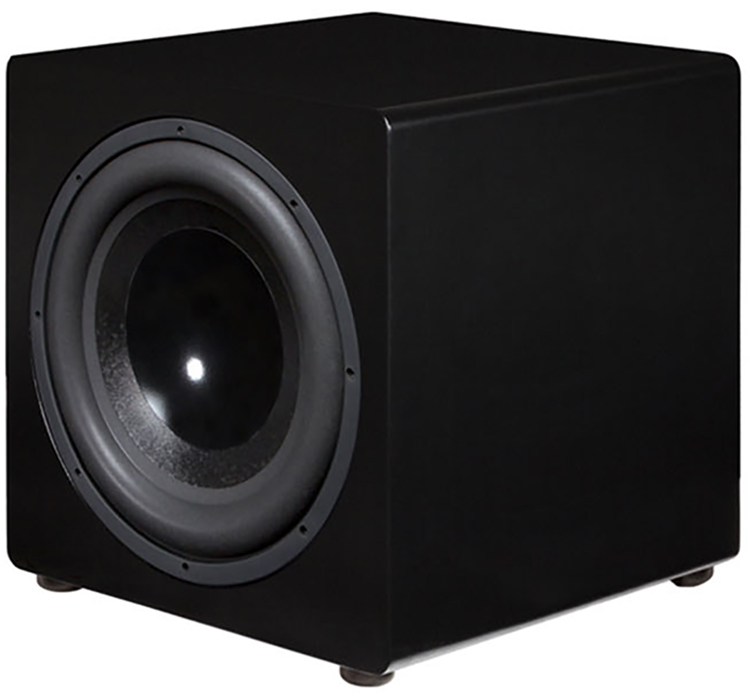
HSU Research ULS-15 MKII Subwoofer
- 15-inch driver with sealed cabinet
- 600-watt BASH amplifier
- Internet-direct sales
- Relatively compact
- 30-day in-home trial
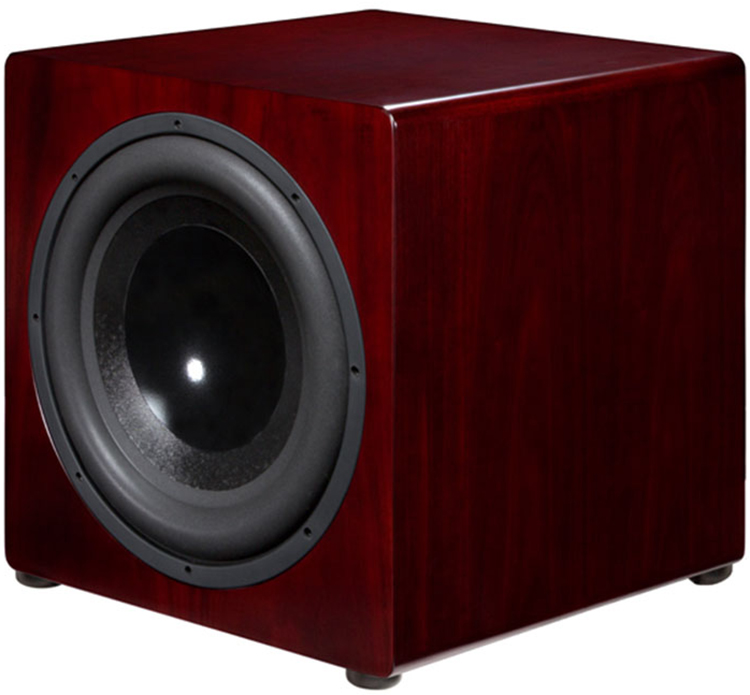
A little over 12 years ago, I took my first gamble with an Internet-direct dealer for an audio component purchase. I had been searching for a great subwoofer for my new media room and wanted something that could deliver gut-wrenching bass without breaking the bank. I had read some rave reviews about a small company in California founded by Dr. Poh Ser Hsu making subs that were highly praised not just by the subsonic-seeking home theater nuts but also by serious audiophiles. After weeks of research, I placed an order for a Hsu Research VTF-3 MKII. That subwoofer is still a part of my system today though I have heard many other (often far more expensive) designs since then. The VTF-3 MKII was an amazing design for its day, able to deliver bass down to around 16Hz (in the right room) at very high SPL levels. For a ported design, it isn’t flabby sounding either. I have traditionally favored sealed subwoofer designs when musical accuracy is the goal, but the VTF-3 MKII is probably the tightest sounding ported design (with one of its two ports plugged) I’ve ever heard. However, with my recent acquisition of a full set of Sonus faber Olympica speakers (see review here), I was starting to feel the need for an even tighter-sounding sub to pair with them. While my VTF-3 did an admirable job, it just didn’t seem to blend perfectly with the Olympicas. Conveniently, Hsu Research had just decided to update its sealed-box ULS-15 design to MKII spec. Given the original ULS-15’s reputation for delivering clean, accurate bass I figured that the improved MKII version would be even better, so I requested a ULS-15 MKII for review.
Design:
Sealed box subwoofer
Drivers:
1 x 15-inch woofer (front-firing)
Input Connectors:
1 x stereo XLR, 1 x stereo high-level, 1 x RCA LFE, 1 x RCA low-level
Crossover:
30-90Hz, By Passable
MFR:
20-200Hz (+/- 1dB)
Amplifier Type:
BASH
Amplifier Power:
600W RMS, 2000W peak
Dimensions:
19 H x 18 W x 19.5 D inches, including feet and grille
Weight:
65 pounds
Finishes:
Satin black or Rosenut veneer ($150 upcharge)
Warranty:
7 years on woofer, 2 years on electronics
MSRP:
$1199 (currently $779 + $69 US shipping), + $150 for Rosenut veneer)
Company:
SECRETS Tags:
HSU Research, ULS-15 MKII Subwoofer, HSU Research Subwoofer, Subwoofer Reviews
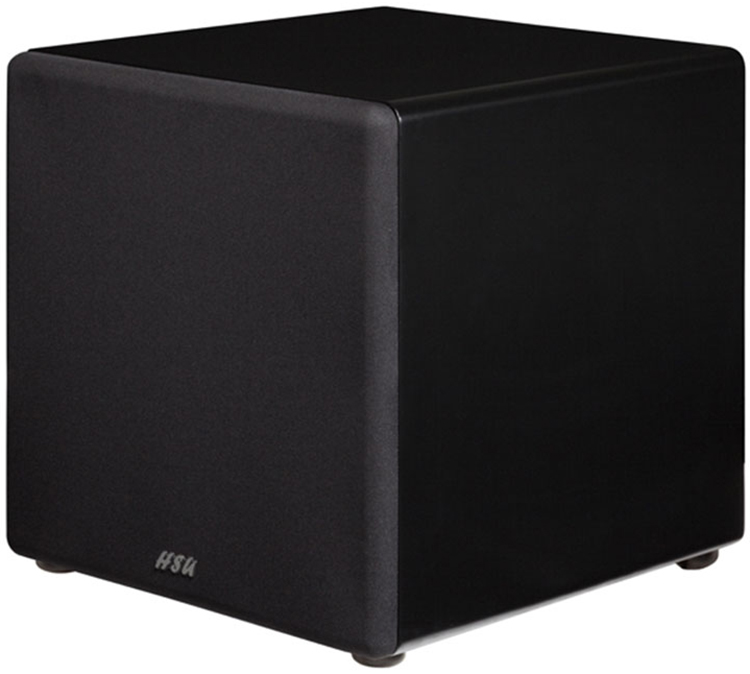
The ULS-15 MKII takes a standard approach in its design. The sub is an 18-inch cube, not including the feet, grille or amplifier heatsinks. Considering the beefy 15-inch front-firing woofer, it’s pretty compact. I was pleasantly surprised by how relatively unobtrusive the ULS-15 was. I think the satin black finish of my review sample deserves some of the credit. Compared to the piano-gloss black of my old VTF-3, the satin black helps the sub blend into my room better and gives the ULS-15 MKII an understated yet purposeful look. I appreciated this stealth look but those of you looking for something a bit fancier can select a beautiful Rosenut veneer for an extra $150. The overall fit and finish of my review sample was excellent without a single nick or variation to the finish that I could spot. Constructed of one-inch MDF, the cabinet feels sturdy and solid. Hitting my knuckles against any side resulted in a very muted thunk. The removable grill is magnetically attached which means no ugly holes if you prefer to run your sub naked. A simple Hsu logo adorns the bottom of the grille. Four feet underneath anchor the sub to the floor. Also worth noting is that there are no annoying lights anywhere on the top or front panels that need to be dimmed or turned off.
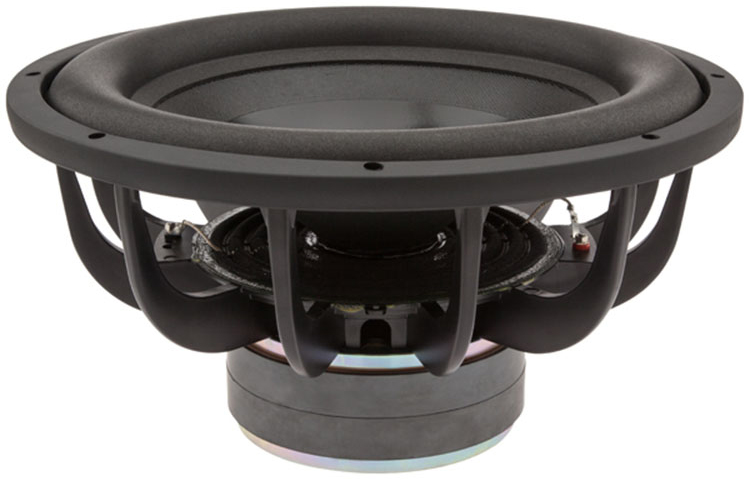
Moving around to the back panel the first thing that catches your eye is the heatsink for the BASH amplifier. Rated at 600W RMS and 2000W peak output, this plate amp can put out some pretty serious power. On the input side, there are a pair of balanced stereo XLRs, two high-level amplifier inputs, an RCA LFE input and a second low-level RCA input. For the controls there is a volume knob, phase switch (0 or 180 degrees), operating mode switch (EQ1 or EQ2), Q control, crossover frequency, crossover defeat (in or out) and a three mode power switch (on, off, or auto). There is also a voltage selector switch (120V or 240V) and replaceable fuse holder as well as a standard IEC power cord input. All of the controls are clearly marked and intuitive but I would prefer if Hsu could find a way to cover the controls to protect your settings from would-be tinkerers. Better yet would be to move the controls to the front of the sub under a covered panel of some type.
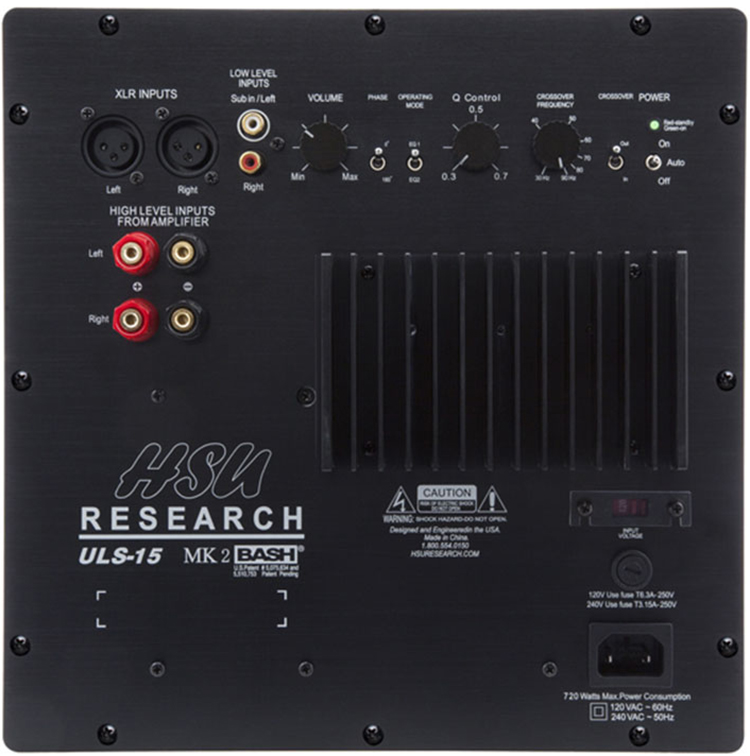
Setting up the ULS-15 MKII was about as easy as it comes. The unit arrived in very sturdy, double-boxed packaging. Additional cardboard corner reinforcements further protected the corners of the interior box from damage. Within the interior box, custom molded foam with additional layers of soft foam protected the double-wrapped subwoofer. There was also a small accessories box that included the power cord and a copy of Hsu’s excellent bass testing CD. This was some of the best packaging I’ve ever seen and I doubt even UPS could damage one of these subs in transit. Once unboxed, I moved the sub to its first test location and hooked up the power cord and a single RCA LFE connection to my Marantz AV-8801 pre/pro.
Prior to receiving my review sample, I had an email exchange with Dr. Hsu regarding my room setup and subwoofer placement options. Not only do I have a very large room (about 5000 cubic feet), but it is not a perfect square or rectangle, so it can be tough to get even bass response at my main seating area, particularly with a single subwoofer. Via some frequency sweeps of my VTF-3, we were able to identify potential placement areas for the ULS-15MkII. Dr. Hsu’s recommendations were excellent and I got very even bass response in his recommended location with the ULS-15 MKII along the back wall about six feet behind my listening seat. EQ1 seemed to generate the most output at the lower frequencies so I stuck with that. A Q setting of .7 gave me about 2dB more output below 40Hz compared to the lower Q settings. I also moved my seat about two feet closer to the back wall. As you can see in the graph below (generated via XTZ’s Room Analyzer II Pro system) I had very tight response from about 24Hz through 80Hz. The Audyssey Pro system in my Marantz pre/pro was able to get this response almost ruler flat up to 150Hz, but unfortunately couldn’t do anything to bump up the output below 24Hz. One thing to note, the manual recommends EQ1 and a Q setting of .7 if you are going to be using a room correction system such as Audyssey to prevent over-boosting of the lowest frequencies.
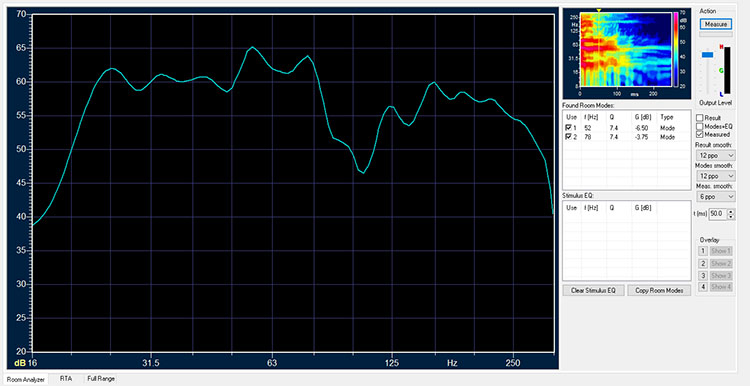
Wanting to see if I could squeeze a little more low bass output out of the Hsu, I moved the sub around a bit more and eventually settled on placing it about one foot behind my main seat. This netted me about another 5dB at the same volume setting on the Hsu’s back panel and slowed the sub’s roll-off from 24Hz down. The graph below shows the response of the sub at this new location. Note that this graph and the earlier one show the frequency response of the sub at my listening position before any additional EQ/processing is used. This netted a pretty tight +/- 5dB response from about 18Hz all the way up to almost 250Hz. Adding Audyssey Pro correction on top of this got me near ruler-flat bass response from about 18Hz all the way up to my highest crossover point of 120Hz. Consider me impressed. With the sub all set, it was time to sit back and enjoy some music and movies.
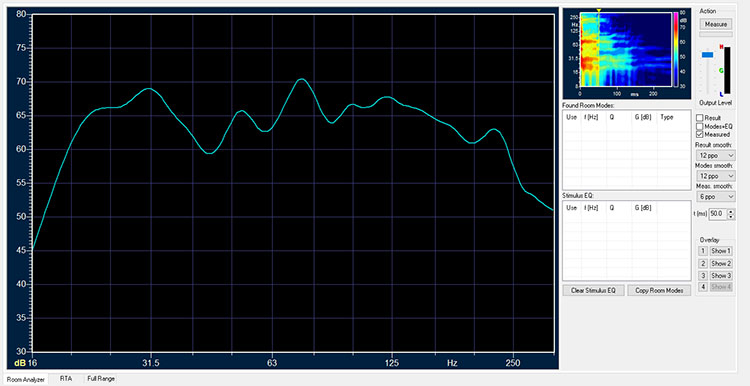
Considering the very even bass response I was able to get from the ULS-15 MKIII, I expected to really enjoy my time with the sub. And I was not disappointed. The Hsu proved to be an excellent match for my Olympica IIIs towers on two-channel sources.

The Olympicas start rolling off around 35Hz in my room and the ULS-15 MKII filled in everything below that point very nicely. Well-recorded classical and jazz music showed the ULS-15 MKII’s attributes to great effect. My standard test tracks from Rachmaninoff’s Symphonic Dances (CD: Reference Recordings RR-96CD) showed just how tight and accurate the Hsu was.
The tympani hits were very crisp with no overhang or bloat. I could hear the initial thwack and could follow each hit of the skins as they faded away or were replaced by the next note. More importantly, the Hsu blended in very well with my main speakers and I was unable to tell when the bass transitioned from the fronts to the sub.
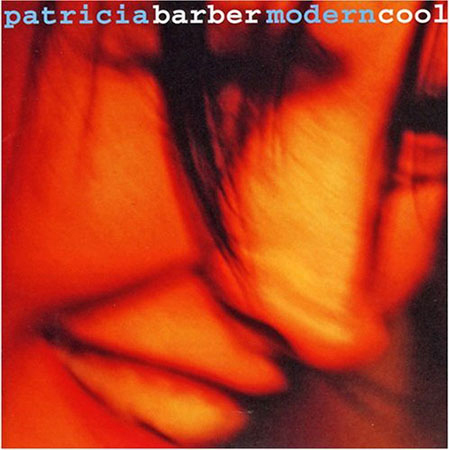
Company and She’s a Lady from Patricia Barber’s Modern Cool (CD: KOCH Records B000V9C5EE) showed just how well the Hsu could do with acoustic string bass. The individual notes had just the right amount of impact and natural body but didn’t blend into each other. Even when the tempo of the bass notes sped up, there was no smearing or merging of one note into the next. These examples really highlight the advantages of a sealed sub. If accuracy and definition are your primary goals, sealed is the way to go.

Wanting to push the Hsu a bit more after the relatively easy work it made of classical and jazz, I loaded up an old torture test from my car-audio days: Bass Jamz: Maximum Techno Bass Mix (CD: Neurodisc Records B01ABBXFCM). Each track on this disc contains high volume, sub-20Hz content (as low as 5Hz in cases), specifically designed to test a subwoofer’s mettle. The warning on the front cover stating “Mega Low Digital Bass May Damage Speakers” is no joke in this case. Track 3, Bass Vibration features a note that starts out around 40Hz then drops to about 20-25Hz before going subsonic.
Those first two notes completely energized my room (and found a few new rattles for me to dampen) before falling off as the note went below hearing range. While I couldn’t hear that third, approximately 15Hz note, the vibration I was feeling in my butt and the air I could feel fluttering around my head told me that the Hsu was still producing some solid output in the subsonic range. This was excellent performance, particularly for a sealed sub. I skipped through quite a few of these tracks, raising the volume to near ridiculous levels until I did manage to make the ULS-15 cry uncle on a few occasions. This is about the only disadvantage to a sealed sub like this. While the Hsu can go very deep, some ported designs (included Hsu’s own) can go a bit deeper and concurrently achieve higher peak SPL levels.
I found that the addition of the ULS-15 MKII made my Olympica IIIs sound like bigger and better speakers, which is what a good subwoofer should do. Did the Hsu mate as seamlessly with my Olympicas as the Sumiko S.9’s (see review here) did? Well, if I am splitting hairs – no. The combination of the S.9’s smaller 10” drivers and the Neutrik high level input was absolutely perfect to my ears. The ULS-15 MKII produced just a bit less of that “one speaker” effect than the Olympica IIIs and S.9s had. However, the Hsu could reach so much deeper and with such a higher level of output that for most content, I’d rather have the Hsu in my system.

Switching over to Blu-ray movie soundtracks further cemented my opinion of the ULS-15MkII. The most recent James Bond film, Spectre has a fantastic DTS-HD Master Audio track anchored by some great bass. The introductory scene’s huge explosions and helicopter battle were loud, fun and room-shaking with the Hsu in the mix. As expected the bass was not of the one-note variety but nuanced and defined where called for. Even with the varying crossover points of my different speakers, I never picked up where they were rolling off and the Hsu was taking over.

The latest film in the Divergent series, Insurgent, had a couple of great bass moments in its Dolby Atmos track as well. In particular, the Dauntless Simulation scene where Tris’ mother is carried away inside her Abnegation-style home was simply pummeling from a bass perspective. Incredibly high in output and very deep, my room was shaking for about two minutes straight as the house broke free from the ground and then continued to fly through the ruins of Chicago. The ULS-15 MKII didn’t break a sweat through this whole passage.

I finished up my listening tests with Star Wars: The Force Awakens. While I feel that there were some questionable choices taken with the plot and dialogue of this film, the DTS-HD Master Audio 7.1 audio track was nearly flawless. In the scenes where Kylo Ren used his Force powers to read the minds of Poe Dameron and Rey, the Hsu truly awoke and rumbled through my room with authority.
The sustained bass pressurized my room for extended periods and really lent a sense of weight to these scenes. The rumble of the First Order star destroyers was perfectly ominous and the hyperspace travel scenes with the Millennium Falcon had the perfect punch when the ship first hits light speed.
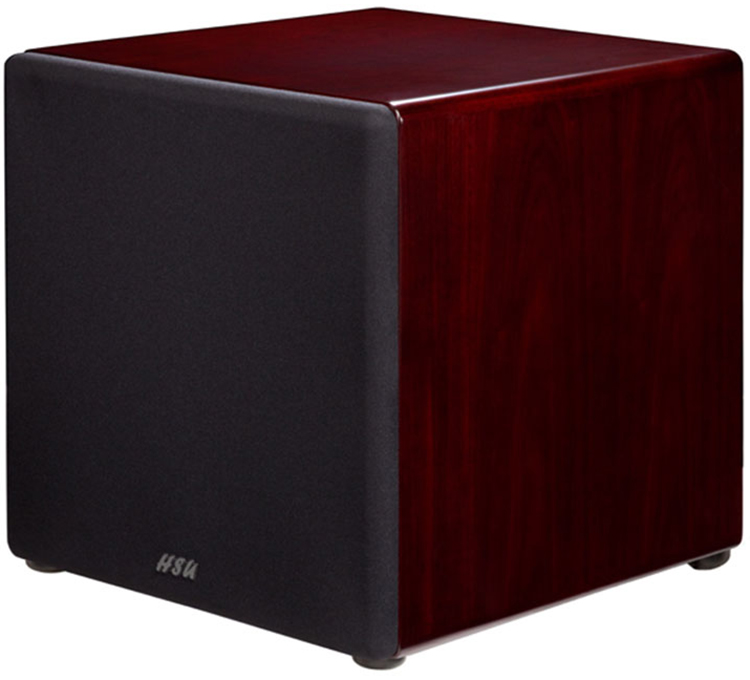
THE HSU RESEARCH ULS-15 MKII SUBWOOFER is one Heck of a Bargain Given its Remarkable Combination of Accuracy, Depth and Raw Power.
- Excellent build quality
- Clean minimalist design
- Relatively small size
- Very tight accurate bass
- Can easily hit 20Hz (or lower) in most rooms with authority
- Powerful enough for all but the largest spaces
- Q control and multiple response modes allow fine-tuning of bass output
- Great for both music and movies
- Sealed design is less sensitive to room placement than most ported subs
- Excellent value
- Excellent price-to-performance ratio
- More finish options (currently just Satin Black or Rosenut Veneer)
- Deeper bass extension and greater output is always welcome
- Cover for controls
Given how much you could spend on a subwoofer in today’s market, $779 (plus shipping) for the Hsu Research ULS15-MkII is one heck of a bargain given its remarkable combination of accuracy, depth and raw power.
To my ears, the Hsu ULS-15 MKII is just about everything you could want in a subwoofer. Its sealed design is amazingly accurate and delivers clean tight bass that suits music particularly well but is just as beneficial for movie soundtracks. The Hsu is also relatively compact and blends into a room far better than much of its competition. The only trade-offs to the sealed-box approach are a decrease in sub-20Hz bass reproduction and a few dB less of overall output (which is still pretty prodigious) compared to similar 15-inch ported designs. However the increased musical accuracy and superior speaker integration offered by a great sealed sub like the ULS-15 MKII outweighs the loss of that little bit of volume and depth, at least in my book. If you have a particularly large room (over 4000 cubic feet or so – like me) and need (or want) more bass output, just install two of these sleek little monsters. Hsu will even cut you a better deal on a ULS-15 MKII DualDrive package – currently just $1499 plus $138 shipping. Not only will you get up to 6dB of additional output, but you could then place the two subs in different locations, which will typically provide smoother overall bass response in most rooms. For anyone who cares equally about music and movie performance, the ULS-15 MKII is an excellent choice. So much so that I purchased my review sample.



